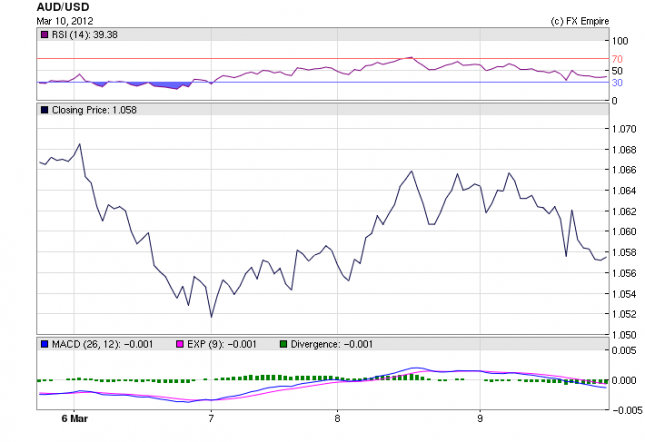By FX Empire.com
Rule: The Australian dollar still isn’t in its good old days, but the performance is definitely improving. Resistance lines tend to work in a smoother manner than support lines, but they also work well. The pair move well together, not much volatility, but easy to chart and easy to trade with low risk factors

AUD/USD Weekly Fundamental Analysis March 12-16, 2012, Forecast
Weekly Analysis and Recommendation:
The AUD/USD is trading at 1.0576 down from a high earlier in the week of 1.0819. The USD is up against all of its trading partners after a better than expected jobs report. The Aussie has been fighting tough economic news from its trading partners with disappointing news from China and Japan this week along with a lower than expected trade deficit report and a slightly higher unemployment rate. The Aussie should show some strength this week as it is trading too low and should be heading towards the 1.0650 to 1.07 range. With the RBA holding rates, there should be some money flow here. This week we should see traders moving out of the USD and Gold and looking for some more risky assets. The Aussie can find some support around 1.0572 level.
Highlights of the past week
USA
The U.S. created 227,000 jobs in February and more people found work in the prior two months than previously reported, suggesting the economy’s recent momentum is likely to continue.
The unemployment rate, meanwhile, was unchanged at 8.3% as nearly half-a-million workers reentered the labor force in search of job, the Labor Department.
Household debt edged up 0.3% in the fourth quarter, the Fed reported in its flow-of-funds report, as consumer credit surged at a 7% annualized rate. Household debt had declined for 13 consecutive periods before the slender fourth-quarter advance.
The U.S. trade deficit widened sharply in January, driven higher by record imports of autos, capital goods and food, government data reported. The trade gap expanded 4.3% in January to $52.6 billion from $50.4 billion in December.
The Fed is considering a new form of “sterilized” quantitative easing that would allow asset purchases despite high oil prices, according to a report in The Wall Street Journal. Under the new approach, the Fed would print new money to buy long-term mortgage or Treasury bonds but effectively tie up that money by borrowing it back for short periods at low rates. The aim of such an approach would be to relieve anxieties that money printing could fuel inflation later, a fear widely expressed by critics of the Fed’s previous efforts to aid the recovery.
The Canadian Central Bank held rates today at 1% following the lead of banks around the world.
The Institute of Supply Management said its non-manufacturing PMI climbed to 57.3 in February from a reading of 56.8 the previous month. Economists had expected the index to decline to 56.1.
Another report showed that U.S. factory orders fell, but at a slower than forecast rate in January, declining by a seasonally adjusted 1.0%, compared to forecasts for a 1.3% slide.
Asia
Australia posted a seasonally-adjusted trade deficit of 673 million Australian dollars ($717.2 million) in January, the Australian Bureau of Statistics said Friday. Economists had been expecting a surplus of A$1.5 billion
China’s consumer price index rose at a weaker-than-expected rate of 3.2% in February from the same month a year earlier. The producer price index for February came in at 0%, also weaker than expected and slowing from January’s 0.7% year-on-year increase.
China’s industrial production and retail sales growth weakened in the first two months of 2012 from the year-earlier period, an official data release showed Friday.
The New Zealand Reserve Bank has held the official cash rate at its historic low of 2.5 per cent at its review. Reserve Bank Governor Alan Bollard opted against making a rate change when releasing the quarterly monetary policy statement. He said if the New Zealand dollar remained at its high levels it would lessen the need to raise the rate. Dr Bollard says the New Zealand economy was continuing to improve despite the export sector being impacted by the high dollar.
Australia’s seasonally-adjusted unemployment rate increased 0.1 percentage points to 5.2% in February, the Australian Bureau of Statistics said Thursday Australia’s fourth-quarter gross domestic product rose 0.4% against economists’ expectations of a 0.8% gain, disappointing government officials and the markets.
South Korea kept its key interest rate on hold at 3.25% on Thursday, according to reports. The decision was widely expected.
Japan’s trade deficit widened in January to 1.382 trillion yen ($17.0 billion), up 245.9% compared to the year past. Japan’s current account deficit totaled 437.3 billion yen in the month. The trade deficit and current account deficit were the largest on record.
China will extend yuan-denominated loans to other nations that make up the Bric group of nations.
Japan’s crude imports from Iran in January fell 23 percent from a year ago to 1.67 million kiloliters, or 338,900 barrels a day, according to data from the Ministry of Economy, Trade and Industry
Premier Wen Jiabao, in his annual state-of-the nation report to China’s parliament, reduces growth for 2012 of 7.5 percent. That would be the slowest pace of expansion since 1990 and well down on last year’s 9.2 percent growth rate.
Japan’s unemployment rate inched up to 4.6 per cent in January from a revised 4.5 per cent in the previous month.
January household spending fell by an inflation-adjusted 2.3 per cent year-on-year. The fall was bigger than a 0.8 per cent drop economists had expected.
The nation didn’t sell any of its currency from Jan. 30 to Feb. 27, the ministry’s month-end data posted on its website shows.
Companies’ capital spending jumped by the most in nearly five years in the fourth quarter. Capital spending excluding software rose 4.9 percent from a year earlier, after declining 11 percent in the previous quarter.

The week ahead brings a vast assortment of economic indicators. A busy week with the news dominated by the US interest rate decision and inflation data.
Monday sees data on credit card lending and debt released by the RBA in Australia.
Also we have housing finance data and new car sales figures will be released. As well as the Reserve Bank of Australia will release its March quarter bulletin.
The Bank of Japan will make its interest rate decision for March.
In Europe, European Union finance ministers are scheduled to meet.
Mondaysees the United Nations economic and social council hold its annual spring meeting
The US treasury budget data will be released.
On Tuesday, the Australian Bureau of Statistics will release housing finance data for January. National Australia Bank is due to release its business confidence and conditions index for the month of February.
IN the US, the Federal Reserve hold its March meeting, where it will decide on the current level of interest rates in the country. Also January business inventories and February retail sales data are also due.
Also on Tuesday, The World Trade Centre committee on budget, finance and administration will hold a meeting.
Chinese Premier Wen Jiabao will hold his annual press briefing at the China National People’s Congress.
Wednesday sees the ABS release December housing starts data. Westpac Banking Corporation and the Melbourne Institute will release their consumer sentiment index for March.
In the United Kingdom, average earnings data for the three months to March will be released. Also February claimant count data and ILO unemployment rate figures for March will also be released.
Across the Atlantic US import and exports price data released, while current account balance data for the December quarter is due.
The weekly Energy Information Administration petroleum status report is also on tap, as well as weekly Mortgage Bankers Association mortgage applications data.
Wednesday afternoonsees World Bank deputy vice finance minister for international affairs Masatsugu Asakawa address a eurozone crisis conference hosted by the Asia Development Bank Institute.
US Federal Reserve chairman Ben Bernanke will speak at the 2012 Independent Community Bankers of America national convention
Thursday brings January lending finance data for the month of January in Australia also new car sales data for February is also set for release.
Elsewhere, the Melbourne Institute will release both its consumer inflation and employment expectation surveys for March.
Thursday morningdelivers US jobless claims data and the February producer price index in the US.
Along with several other releases in America including, The Philadelphia Federal Reserve survey and the US Treasury international capital data is on tap, alongside the New York Empire State Manufacturing Survey.
Friday brings highly anticipated consumer price index data for February in the US.
The Reuters/Michigan consumer sentiment index for March and industrial production for February data will also be released.
On Saturday, the Organization for Economic Co-operation and Development will release its interim assessment.
Economic Events for AUD-NZD-JPY-USD this week
|
Mar. 12 |
19:00 |
USD |
Federal Budget Balance |
|
Mar. 13 |
00:30 |
AUD |
Home Loans (MoM) |
|
00:30 |
AUD |
NAB Business Confidence |
|
|
03:30 |
JPY |
Interest Rate Decision |
|
|
Tentative |
JPY |
BoJ Press Conference |
|
|
12:30 |
USD |
Core Retail Sales (MoM) |
|
|
12:30 |
USD |
Retail Sales (MoM) |
|
|
18:00 |
USD |
10-Year Note Auction |
|
|
18:15 |
USD |
Interest Rate Decision |
|
|
18:15 |
USD |
FOMC Statement |
|
|
21:00 |
NZD |
Westpac Consumer Sentiment |
|
|
23:50 |
JPY |
BSI Large Manufacturing Conditions |
|
|
Mar. 14 |
05:00 |
JPY |
BoJ Monthly Report |
|
12:30 |
USD |
Current Account |
|
|
12:30 |
USD |
Import Price Index (MoM) |
|
|
23:30 |
AUD |
Westpac Consumer Sentiment |
|
|
23:50 |
JPY |
Tertiary Industry Activity Index (MoM) |
|
|
Mar. 15 |
00:30 |
AUD |
RBA Financial Stability Review |
|
04:30 |
JPY |
Industrial Production (MoM) |
|
|
12:30 |
USD |
Core PPI (MoM) |
|
|
12:30 |
USD |
PPI (MoM) |
|
|
12:30 |
USD |
Initial Jobless Claims |
|
|
12:30 |
USD |
NY Empire State Manufacturing Index |
|
|
12:30 |
USD |
Continuing Jobless Claims |
|
|
13:00 |
USD |
TIC Net Long-Term Transactions |
|
|
14:00 |
USD |
Philadelphia Fed Manufacturing Index |
|
|
23:50 |
JPY |
Monetary Policy Meeting Minutes |
|
|
Mar. 16 |
12:30 |
USD |
Core CPI (MoM) |
|
12:30 |
USD |
CPI (MoM) |
|
|
13:15 |
USD |
Industrial Production (MoM) |
|
|
13:55 |
USD |
Michigan Consumer Sentiment Index |
Government Bond Auction Schedule (this week)
Mar 12 10:30 Germany Eur 4.0bn new Sep 2012 Bubill
Mar 12 18:00 US Auctions 3Y Notes
Mar 13 09:30 Netherlands Eur 2.5bn-3.5bn re-opened Apr 2015 DSL
Mar 13 10:10 Italy BOT auction
Mar 13 10:30 Belgium Auctions 3 & 12M T-bills
Mar 13 15:30 UK Details gilt auction on Mar 22
Mar 13 18:00 US Auctions 10Y Notes
Mar 14 10:10 Italy BTP/CCTeu auction
Mar 14 10:10 Sweden Auctions T-bills
Mar 14 10:30 Swiss Bond auction
Mar 14 15:30 Sweden Details nominal bond exchange auction on Mar 21
Mar 14 18:00 US Auctions 30Y Bonds
Mar 15 09:30 Spain Obligacion auction
Mar 15 09:50 France BTAN auction
Mar 15 10.30 UK Auctions 4.5% 2042 conventional Gilt
Mar 15 10:50 France OATi auction
Mar 15 16:00 US Announces auction of 10Y TIPS on Mar 22
Originally posted here



